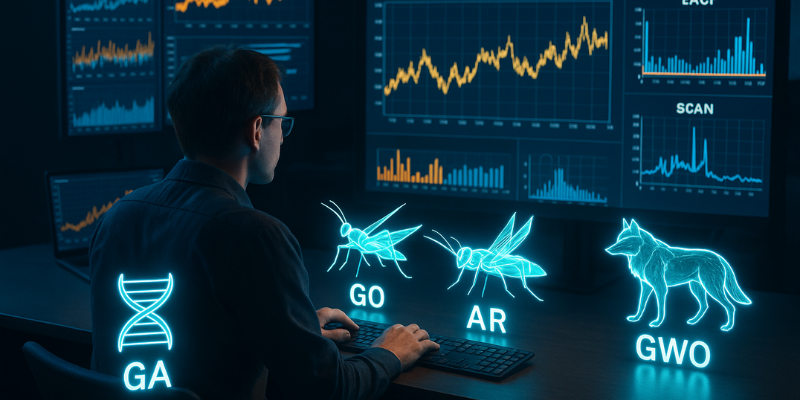AR model calibration is a crucial step in time series analysis, directly impacting forecasting accuracy and insights derived from data. AutoRegressive (AR) models describe time series data by expressing current values as linear combinations of past observations. However, the true power of AR models lies in correctly calibrating model parameters and selecting the right model order.
In this article, we’ll explore popular AR model calibration techniques—MINIC, SCAN, and EACF—and show how modern optimization algorithms like Genetic Algorithm (GA), Grasshopper Optimization (GO), and Grey Wolf Optimization (GWO) can significantly enhance model performance and calibration precision.
Understanding AR Model Calibration
An AR model expresses a time series as:
Xt = ϕ1 Xt-1 + ϕ2 Xt-2 + … + ϕp Xt-p + εt
Here, choosing the right order p and accurately estimating the parameters ϕi is essential for producing a robust model. Calibration methods help identify the optimal model structure, preventing overfitting and improving forecast reliability.
Key AR Model Calibration Methods
Let’s dive into the three widely-used methods for calibrating AR models:
MINIC (Minimum Information Criterion)
- Purpose: Selects the optimal AR model order based on statistical information criteria such as AIC (Akaike Information Criterion) or BIC (Bayesian Information Criterion).
- How It Works: Calculates values of the criterion for different orders and selects the model with the minimum score.
- Advantages:
- Simple and computationally efficient.
- Ideal for initial model selection and comparison.
SCAN (Subset Canonical Analysis)
- Purpose: Detects significant lags in AR models and filters out redundant variables.
- How It Works: Uses canonical correlations between lagged vectors of the time series to identify meaningful lags.
- Advantages:
- Reduces risk of overfitting.
- Particularly effective for large time series datasets.
EACF (Extended Autocorrelation Function)
- Purpose: Graphically identifies suitable ARMA model orders.
- How It Works: Constructs a table of autocorrelations and partial autocorrelations, producing visual patterns (often triangles) indicating possible model orders.
- Advantages:
- Visual and intuitive approach.
- Helps differentiate between pure AR, pure MA, and mixed ARMA models.

Why Use Optimization Algorithms in AR Model Calibration?
Traditional methods like MINIC, SCAN, and EACF effectively determine model structure but can struggle with complex data patterns, non-linear relationships, or high-dimensional parameter tuning. This is where metaheuristic optimization algorithms—GA, GO, and GWO—offer significant advantages.
These algorithms explore vast solution spaces and optimize parameters beyond the reach of purely statistical techniques. Let’s examine how each contributes to AR model calibration.
Genetic Algorithm (GA) for AR Calibration
- Inspired by: Evolution and natural selection.
- Benefits:
- Solves complex, non-linear optimization problems.
- Avoids getting trapped in local minima.
- Highly flexible for hybrid use with methods like MINIC for initial model selection.
Grasshopper Optimization (GO) for AR Calibration
- Inspired by: Swarming behavior of grasshoppers in nature.
- Benefits:
- Balances global exploration and local exploitation.
- Efficient in high-dimensional parameter tuning.
- Simple mathematical structure reduces computational cost.
Grey Wolf Optimization (GWO) for AR Calibration
- Inspired by: Social hierarchy and hunting strategies of grey wolves.
- Benefits:
- Strong convergence toward global optima.
- Fewer parameters to adjust compared to other algorithms.
- Excellent performance for multi-objective optimization.
Benefits of Combining Classical and Metaheuristic Methods
While MINIC, SCAN, and EACF provide strong foundations for AR model order selection, integrating metaheuristic algorithms leads to:
✅ More accurate parameter estimation for superior forecasting performance.
✅ Capability to handle noisy, non-stationary, or complex time series data.
✅ Multi-objective optimization, balancing accuracy with model simplicity.
✅ Higher resilience against overfitting or local minima traps.
Conclusion
In time series analysis, AR model calibration is critical for accurate predictions and insights. Techniques like MINIC, SCAN, and EACF help identify appropriate model structures. However, leveraging optimization algorithms such as Genetic Algorithm (GA), Grasshopper Optimization (GO), and Grey Wolf Optimization (GWO) can dramatically improve parameter tuning and model performance.
By combining traditional statistical methods with modern computational intelligence, you can build AR models that are both precise and robust, leading to better forecasting and deeper understanding of your time series data.
If you’re working with time series forecasting, exploring these hybrid approaches can transform your modeling results and unlock valuable insights hidden within your data.